Motorola Solutions 89FT5811 iDEN iM1100 Wireless Modem User Manual iM1100paper
Motorola Solutions, Inc. iDEN iM1100 Wireless Modem iM1100paper
Contents
- 1. Users Manual
- 2. Addendum to Users Manual
Users Manual

iM1100
Wireless Modem
for WindowsTM 95,
WindowsTM 98, Windows 2000,
and WindowsTM NT
User’s Guide

www.motorola.com/iden

i
Table of Contents
iM1100 Wireless Modem...................................................................................1
Setting Up Your Modem ...................................................................................2
Using the Modem .............................................................................................12
Getting Status Information.............................................................................15
SIM Card Personal Identification Number (PIN) ........................................19
Customer Support............................................................................................22
Accessories........................................................................................................23
Safety and General Information.....................................................................24
RF Operational Characteristics .....................................................................24
Portable Radio Product Operation and EME Exposure .............................24
Electro Magnetic Interference/Compatibility ...............................................27
Medical Devices................................................................................................27
Operational Warnings.....................................................................................29
Operational Cautions ......................................................................................30
Accessory Safety Information.........................................................................32
Glossary ...........................................................................................................34

ii

1
iM1100 Wireless Modem
iM1100 WIRELESS MODEM
ongratulations on purchasing your Motorola iM1100 wireless
modem.
Your iM1100 modem offers wireless access to the internet. This wireless
modem offers the following features:
• Packet Data
• Circuit Data/Fax.
The iM1100 wireless modem and iDEN Wireless Data Services software
provide you with the capability of performing your most important laptop
computer activities, like connecting to the internet or corporate intranets,
from outside your office or home.
Overview
The iM1100 wireless modem enables the following data connections:
• Packet data: Access the Internet, send and receive e-mail, and transfer
small files over the packet data network using standard IP protocols.
Packet data transmits packets (blocks) of data at high speed. After the
data is transmitted, you can remain connected without being charged for
the idle time. Data is sent in bursts.
• Circuit data: Send and receive data (faxes, files, etc.) over the circuit-
switched cellular channel.
C

2
LOGO HERE
www.motorola.com/iden
SETTING UP YOUR MODEM
Installation Requirements
To install the Wireless Data Services software onto your laptop, you need
the following:
• An iM1100 Wireless Modem.
• The Wireless Data Services software (provided in your package)
• An IBM®-compatible PC with:
- An Intel® 586 (or higher) processor
- Microsoft® Windows® 95 installed, Windows® 98, Windows®
NT, and Windows® 2000.
- Minimum 8 MB of addressable RAM
- CD-ROM drive
- 9 MB free hard-disk space
- Recommended: Mouse or compatible pointing device
• Communication software
• An account with an iDEN service provider
Starting the Software Installation
To begin installing the Wireless Data Services software:
1. Turn on your computer and start Windows 95, Windows 98,
Windows NT, and Windows 2000.
2. Insert the Wireless Data Services software CD-ROM in your CD-
ROM drive.
3. Start the iM1100 wireless modem installation program.
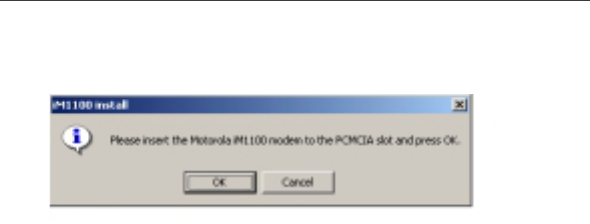
3
Setting Up Your Modem
Inserting the iM1100 Wireless Modem
After you open the the installation program, this prompt appears:
1. Insert your SIM card into the iM1100 wireless modem as directed in
the instructions on the back of the modem.
2. Insert the iM1100 wireless modem into the PCMCIA slot in you
laptop.
3. Click OK.
Installing on Windows 2000, Windows NT, or
Windows 95 and Windows 98
From this point in the installation, the steps you take depend on the
operating system running on your laptop:
• If you are using Windows 2000, see “Completing the Installation on
Windows 2000” on page 3.
• If you are using Windows 95 or Windows 98, see “Completing the
Installation on Windows 95/Windows 98” on page 5.
• If you are using Windows NT, see “Completing the Installation on
Windows NT” on page 7.
Completing the Installation on Windows 2000
1. Before continuing to install the iM1100 wireless modem software,
you must first install an update to Windows 2000. When prompted,
click Yes to install the update. Then restart your laptop.
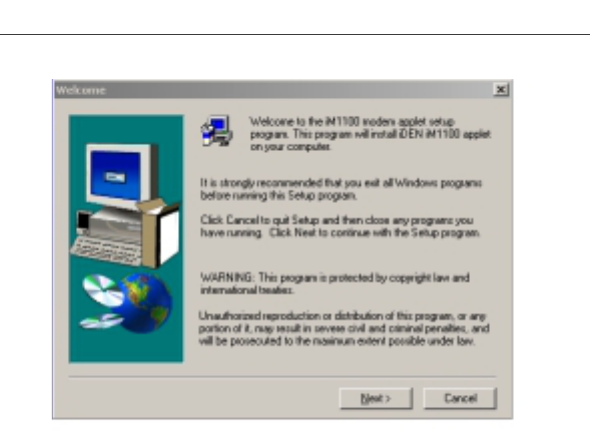
4
LOGO HERE
www.motorola.com/iden
2. Click Next when this welcome window appears:
3. When the User Information window appears, enter your name and
your company’s name. Then click Next.
4. When the Choose Destination Location window appears, choose a
destination location or use the default. Then click Next.
5. In the Select Program Folder window, choose a destination folder, or
use the default. Then click Next.
6. To complete the installation, click Finish in the Setup Complete
window.
After you have competed the installation, make sure that maximum modem
speed in set to 19200:
1. From the Start button, choose Accessories > Communications >
Network and Dial-up Connections.
2. From the Network and Dial-up Connections window, double click
on the iM1100 connection to open it.
3. From the Connecting iM1100 window, click Properties.
4. From the iM1100 window, click Configure.
5. When the Modem Configuration window appears, make sure that the
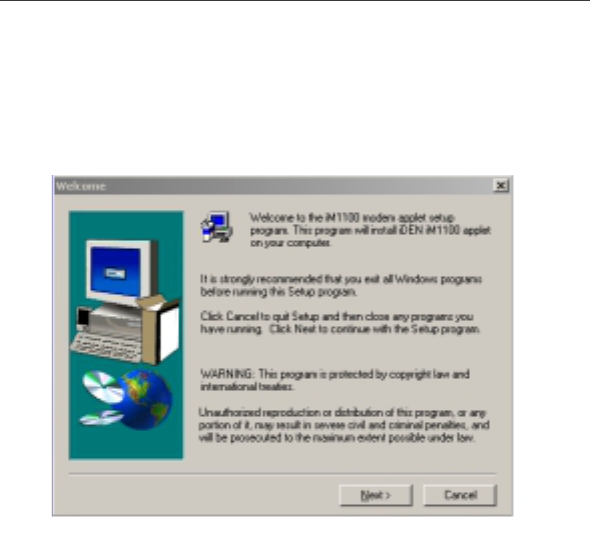
5
Setting Up Your Modem
value shown for Maximum Speed is 19200. If a different value is
shown, select 19200 from the drop-down list.
Completing the Installation on Windows 95/Windows 98
1. Click Next when this welcome window appears:
2. When the User Information window appears, enter your name and
your company’s name. Then click Next.
3. When the Choose Destination Location window appears, choose a
destination location or use the default. Then click Next.
4. In the Select Program Folder window, choose a destination folder, or
use the default. Then click Next.
5. To complete the installation, click Finish in the Setup Complete
window.
6. When the Communication Setting window appears:
• Click “Auto Detect” to let the program automatically detect the
communication port to which your modem is connected and set the
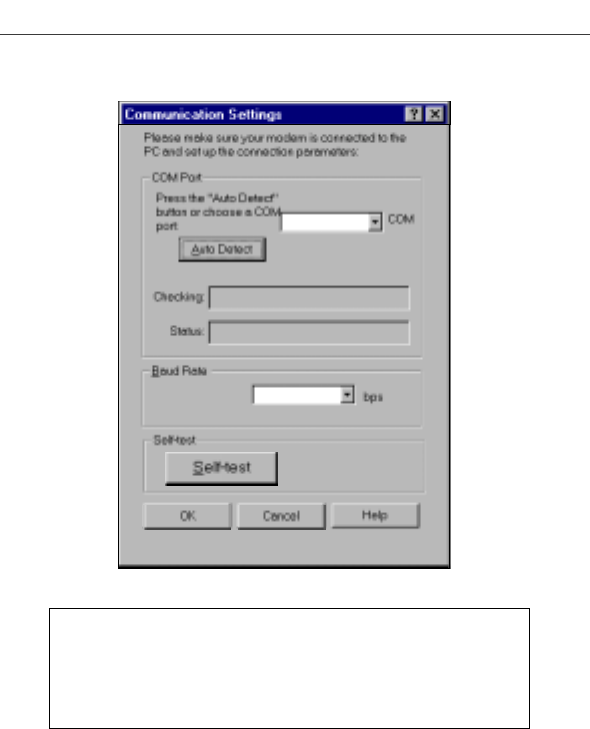
6
LOGO HERE
www.motorola.com/iden
corresponding COM port button.
• Or, select a COM port by clicking its selection button..
7. If you want to change the baud rate, click the down arrow to make
another selection.
Be sure that “Done” appears in the status box before you continue.
8. Click OK. The Setup Complete window opens.
9. To complete the installation, click Finish in the Setup Complete
IMPORTANT
If you do not choose Auto Detect and Accept the default
baud rate of 19200, ensure the settings for the baud rate
setting for your laptop and the baud rate setting for your
iM1100 wireless modem are the same.
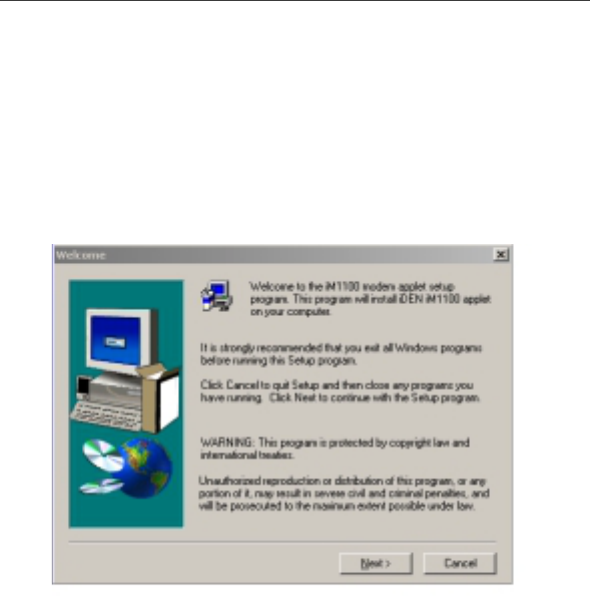
7
Setting Up Your Modem
window.
Completing the Installation on Windows NT
To use the iM1100 wireless modem on Windows NT, you must install the
Wireless Data Services software and configure Remote Access Service
(RAS) for the iM1100 wireless modem. RAS enables you to work outside
as though directly connected to a network
To continue the software installation:
1. Click Next when this welcome window appears:
2. When the User Information window appears, enter your name and
your company’s name. Then click Next.
3. When the Choose Destination Location window appears, choose a
destination location or use the default. Then click Next.
4. In the Select Program Folder window, choose a destination folder, or
use the default. Then click Next.
5. To complete the installation, click Finish in the Setup Complete
window.
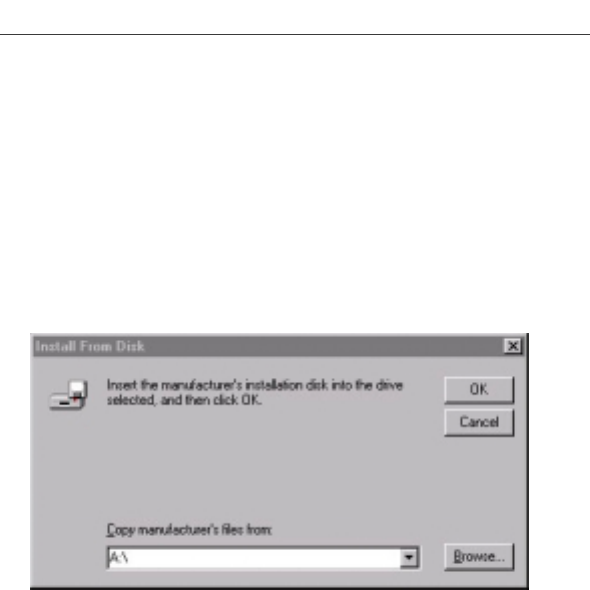
8
LOGO HERE
www.motorola.com/iden
6. An information window appears saying that Wireless Data Services
software will be installed. Click OK.
7. When the Install New Modem window opens, you may allow your
system to search for the modem, or chose to select it from a list. If
you allow the system to select a modem, click Next now and skip to
step 14.
8. Click Next to continue to the modem selection window. In this
window, you can choose a modem from a list of modem
manufacturers and model, or install a modem from a disk. If you
choose a modem from the list, click Next now and skip to step 14.
9. To install a modem from a disk, click Have Disk and then Next to
continue.
10. Type the name of the drive that contains the iM1100 wireless
modem CD-ROM and click Browse to continue to the Locate File
window opens.
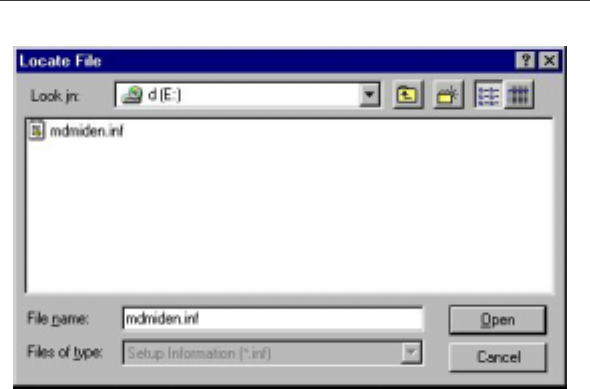
9
Setting Up Your Modem
11. Select the im1100.inf file and click Open.
12. The Install From Disk window appears again. Click OK
13. The Install New Modem window appears again. Make sure that
iM1100 Wireless Modem is selected and click Next.
14. When the Port Selection window appears, select the COM port to
which your modem is connected. Then click Next.
15. Click Finish.
After the software installation is finished, the Configure the Data Modem
in RAS Manager window appears.
To configure RAS for the iM1100 wireless modem:
1. Click OK.
2. In the Network Configuration window, select the Services tab.
Within the Services tab, select Remote Access Service. Then click
Properties.

10
LOGO HERE
www.motorola.com/iden
3. In the Remote Access Setup window, click Add.
4. In the RAS Device window, ensure the COM port for your iM1100
modem is selected. Click OK.
5. The Remote Access Setup window now shows the added COM port.
Click Continue.
6. In the Network Services Selection window, click Close.
7. When the Computer Restart window appears, click Yes.
8. When the Windows banner appears during the computer restart, log on.
The installation will automatically resume. The Setup Complete window
appears.
To complete the installation:
In the Setup Complete window, choose “Yes, I want to restart my computer
now” and click Finish.
Registering Your iM1100 Wireless Modem
Your iM1100 wireless modem must register with your service providers
network before you use it for the first time.
To register your modem after installation, start the Wireless Data Services
software Status Program and connect.
NOTE
If a modem is already inserted in the same COM port as the
iM1100 modem, click “Remove” to remove it and then
click “Add”.
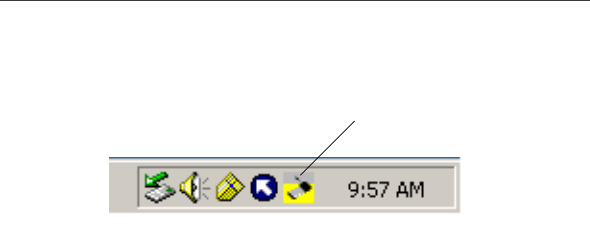
11
Setting Up Your Modem
The LED located on the iM1100 wireless modem and the background of the
iM1100 Wireless Data Services icon on you toolbar turn solid green to
indicate that your modem is packet-data registered.
Setting or Disabling Your SIM PIN
The first time you use your modem, you must choose a SIM PIN or disable
the SIM PIN requirement. See “SIM Card Personal Identification Number
(PIN)” on page 19.
iM1100 Wireless Data Services icon
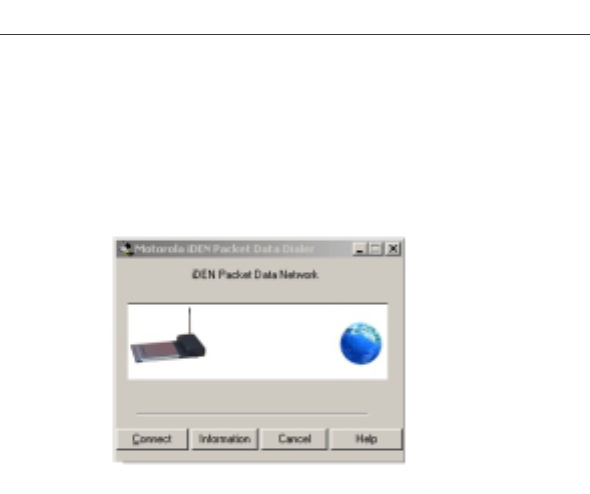
12
LOGO HERE
www.motorola.com/iden
USING THE MODEM
Connecting to the Internet
To connect the iM1100 wireless modem to the internet or an intranet:
1. Start the iM1100 Wireless Modem Services Status Program on your
laptop. This window appears.
2. Click Connect. As the connection starts, you will see the following
messages:
CONNECTING
CONNECTED SUCCESSFULLY
3. If prompted, enter your SIM PIN. See “SIM Card Personal
Identification Number (PIN)” on page 19.
You may now use your modem.
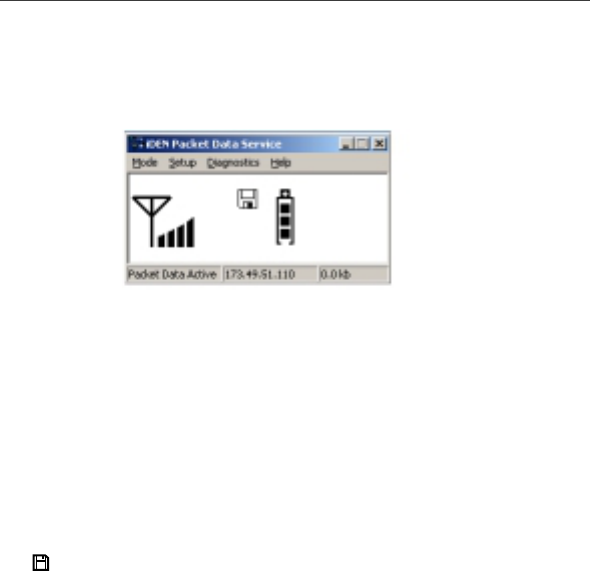
13
Using the Modem
Disconnecting from the Internet
To close your modem’s connection:
1. If the iDEN Packet Data Services window is not open, open it by
clicking on the iM1100 wireless modem icon on your taskbar.
2. From the iDEN Packet Data Services window’s menu bar, choose
Mode > Exit and Disconnect or close the window.
This disconnects your modem from the network and closes the status
window.
When You Are Connected
After you send data, the packet data transfers take place during times when
the iDEN network is not busy. You do not have simultaneous contact with
the addressee.
When your iM1100 modem is connected to your computer with the data
cable, and your packet data modem is selected, you are Packet Data
Registered even if you are not actively transmitting data.
Your PC displays a floppy disk icon, indicating that your
modem is ready to make packet data calls.
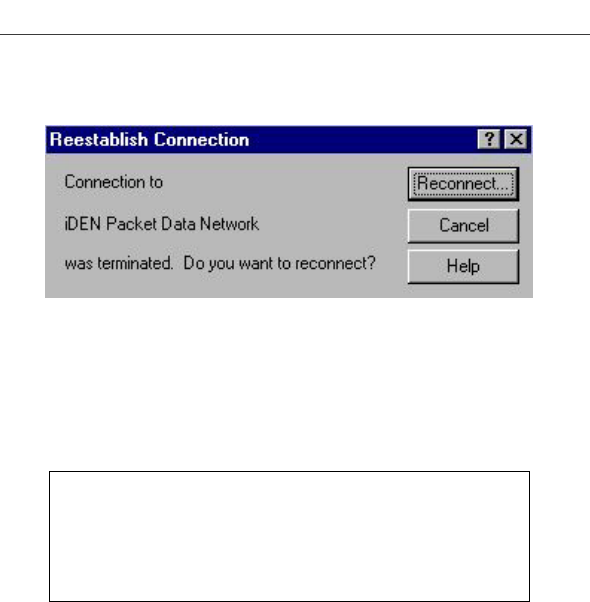
14
LOGO HERE
www.motorola.com/iden
If You Lose Connection
If you lose connection, you will see the following message:
To re-establish your connection, click Reconnect.
Running Applications over Packet Data
You can run any standard TCP/IP application during a packet data session.
NOTE
When a packet-data session is active, any software
specifically configured for use with other service providers
may be required to be reconfigured for use with your
service provider.
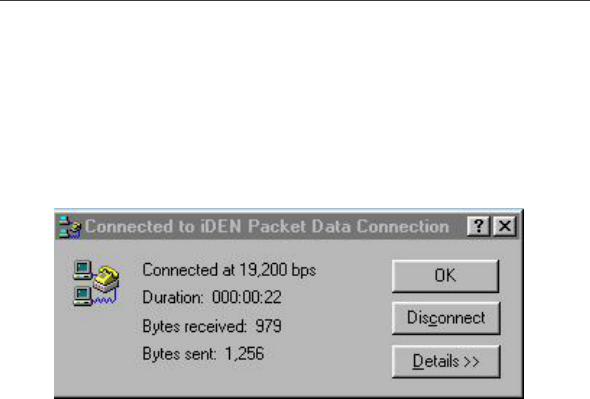
15
Getting Status Information
GETTING STATUS INFORMATION
Using the iDEN Packet Data Connection
Window
To display the iDEN Packet Data Connection window, click the Packet Data
Connection icon located on the taskbar.
This window will provide you the with current connection baud rate,
duration, bytes received, and bytes sent.
Bytes count includes:
• Data sent and received through the iDEN Packet Data Network.
• Data communication (between the modem and the PC) used for showing
your modem’s status during the Packet Data Connection.
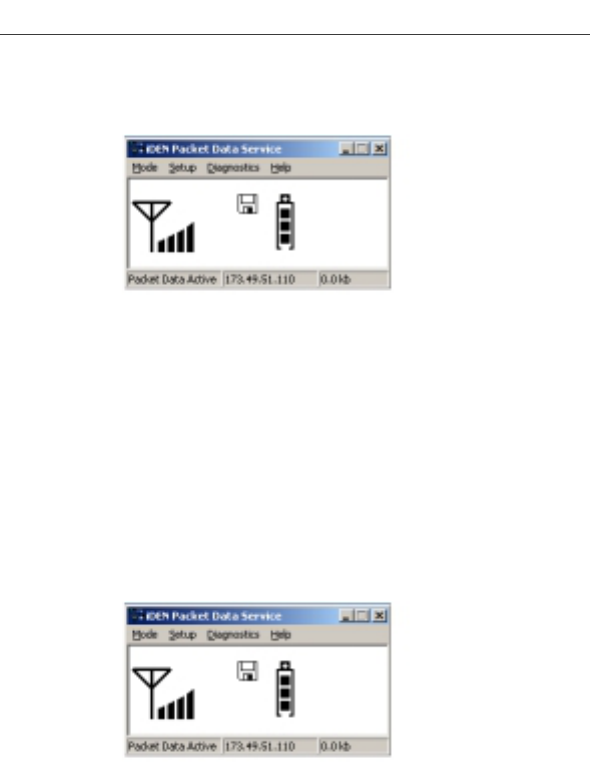
16
LOGO HERE
www.motorola.com/iden
Using the iDEN Packet Data Service Window
To display the iDEN Packet Data Service window click on the iM1100
wireless modem icon on your taskbar.
iDEN Packet Data Service window displays the following information:
• The body window displays status icons that tell you how your modem
in functioning.
• The status bar indicates the Packet Data Status, Equipment IP Address,
and the number of kilobytes that were sent and received through the
iDEN Packet Data Network (during the current connection).
• The options on the window’s menu provide additional status
information during a packet data connection.
Use the Mode option on the menu bar to choose the information that is
displayed:
• Normal mode provides signal strength, battery strength and the number
of kilobytes sent and received for the current packet data session.
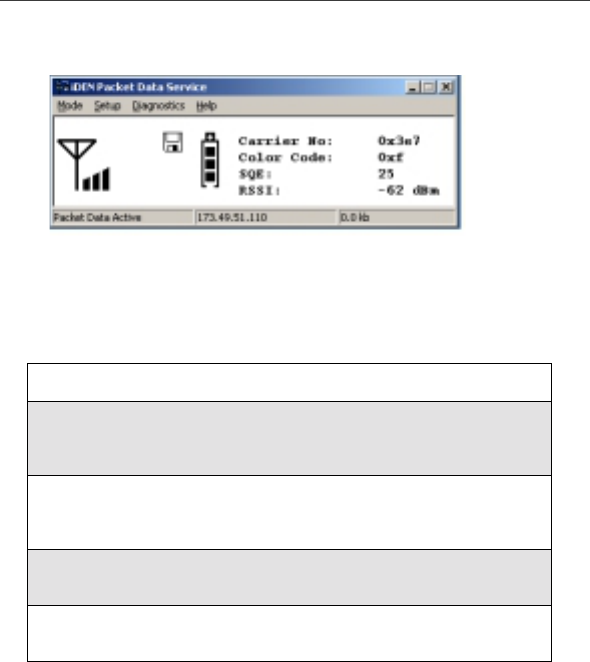
17
Getting Status Information
• Advanced mode displays technical information about service provider,
signal strength, and the number of kilobytes sent and received for the
current packet data session.
Status Icons
These status icons appear in the body of iDEN Packet Data Service
window:
Icon Indicates...
3456 Battery Strength icons — remaining
battery charge. More bars on the battery
indicate a greater charge.
aSignal Strength icons — strength of the
network signal. More bars next to the
antenna indicate a stronger signal.
.Text Message — you have one or more
Text Messages or Net Mail messages.
YPacket Data Ready — phone is ready to
receive data through a data cable.

18
LOGO HERE
www.motorola.com/iden
Advanced Mode Information
The following addition information is displayed in Advanced Mode:
Menu Options
You can access the following menu options form the iDEN Packet Data
Service window
Carrier
No. The hexadecimal equivalent for the service
provider number of a cell
Color
Code The hexadecimal value for the service
provider color code
SQE The decimal value for the Signal Quality
Estimate in decibels (dB)
RSSI The value that represents the signal strength
power received in dBm units.
Mode Sets display to Normal or Advanced, and en
you to Exit and Disconnect.
Setup Preferences enables you to change your
modem’s response time.
Diagnostics Enables you to view and change information
about your host server.
Help Accesses online help.

19
SIM Card Personal Identification Number (PIN)
SIM CARD PERSONAL
IDENTIFICATION NUMBER (PIN)
To prevent unauthorized use of your modem, your SIM card is protected by a
PIN. Each time the modem is powered on, you must enter your PIN. You can
change or disable your PIN if desired.
NOTE: Disabling your PIN enables anyone to use your modem. If you
disable your PIN, you must still keep the SIM card in the modem
to make calls.
Entering the PIN
Depending on your service provider, your modem may or may not require you
to enter a SIM PIN when you first use your modem.
If your modem is set to require you to enter a PIN, your default PIN is 0000. It is
recommended that you change your PIN to prevent fraudulent use of the SIM
card (see “Changing the PIN” on page 20).
To enter a SIM PIN:
1. From the User Settings window, enter your 4- to 8-digit PIN. An
asterisk appears for each character entered.
2. Click OK.
If you enter an incorrect PIN, the message SIM PIN incorrect: Try again
appears. After three consecutive incorrect attempts, the SIM card is blocked.
Once blocked the modem does not allow you to enter your PIN again, even after
powering the modem off and back on. If this happens, see “Unblocking the PIN”
on page 20.
Incorrectly entering your PIN three times
causes the SIM card to be blocked. To
unblock your SIM card, you must contact
your service provider. For more
information, see “Unblocking the PIN” on
page 20.
!
C a u t i o n
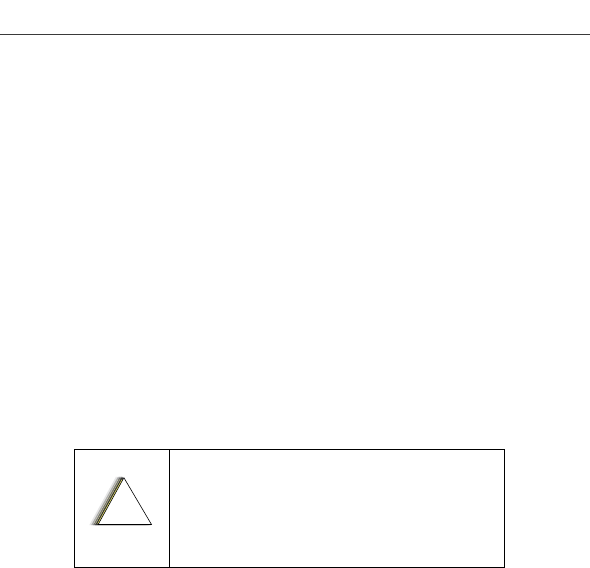
20
LOGO HERE
www.motorola.com/iden
Changing the PIN
To change your SIM PIN:
1. From the User Settings window, enter your current 4- to 8-digit PIN.
An asterisk appears for each character entered.
2. Enter your new 4- to 8-digit PIN. Enter it again to verify it.
3. Click OK.
Unblocking the PIN
If you forget your PIN and unsuccessfully enter it three times, access to your
iM1100 will be blocked.
NOTE: Before you begin, obtain the PIN Unblocking Key (PUK) code
from your service provider, then read and understand the PIN
unblocking sequence. In entering the key press sequence, each
key press must occur within 5 seconds of the prior key press.
Disabling/Enabling the PIN Requirement
When the PIN requirement is enabled, you are prompted to enter your PIN each
time you turn on your modem. Until a valid PIN is entered, you can not use the
modem.
After the PIN is accepted, the modem registers on the network and the idle
screen displays.
If you unsuccessfully enter the PUK code
ten times, the SIM card is permanently
blocked and must be replaced. If this
happens, all data will be lost. You will get a
message to contact your service provider. If
the SIM card is blocked, the modem only
allows outgoing Emergency calls.
!
C a u t i o n

21
SIM Card Personal Identification Number (PIN)
When the PIN requirement is disabled, the modem can be used without entering
a PIN.
If you disable the PIN requirement, you
remove protection of personal data on your
SIM card. Anyone can then use your modem
and access your personal data.
!
C a u t i o n

22
LOGO HERE
www.motorola.com/iden
CUSTOMER SUPPORT
For technical support, contact your service provider. Before you call, have
your subscription number available and make a note of the exact problems
and error messages you encountered.
NOTE
Additional information for iDEN Wireless Data Services
can be found on the Motorola iDEN web site at:
http://www.mot.com/iDEN
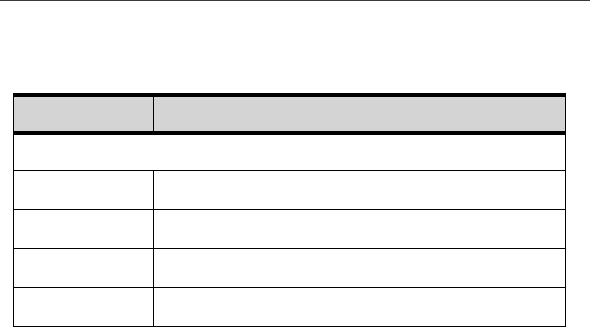
23
Accessories
ACCESSORIES
Table 1: Accessories Table
Kit Number Model Description
ANTENNAS
HAF9067A Mobile Roof Mount Antenna
FAD5524A Mobile Window Antenna
RAF4136AMM Magnetic Antenna
NKN6557A Adaptor Cable for External Antenna

24
LOGO HERE
www.motorola.com/iden
Safety and General Information
RF Operational Characteristics
Your radio product contains a radio frequency transmitter to convey the
information you wish to send as well as occasional automatic signals used to
sustain connection to the wireless network, and a receiver which enables you to
receive communication and connection information from the network.
PORTABLE RADIO PRODUCT OPERATION AND
EME EXPOSURE
Your Motorola radio product is designed to comply with the following national
and international standards and guidelines regarding exposure of human beings
to radio frequency electromagnetic energy (EME):
• United States Federal Communications Commission, Code of Federal
Regulations; 47 CFR part 2 sub-part J
• American National Standards Institute (ANSI) / Institute of Electrical and
Electronics Engineers (IEEE). C95. 1-1992
• Institute of Electrical and Electronics Engineers (IEEE). C95. 1-1999
Edition
• National Council on Radiation Protection and Measurements (NCRP) of
the United States, Report 86, 1986
• International Commission on Non-Ionizing Radiation Protection (ICNIRP)
1998
• Ministry of Health (Canada). Safety Code 6. Limits of Human Exposure to
Radio frequency Electromagnetic Fields in the Frequency Range from 3
kHz to 300 GHz, 1999.
• Australian Communications Authority Radio communications
(Electromagnetic Radiation - Human Exposure) Standard 1999 (applicable
to wireless phones only)
IMPORTANT INFORMATION ON SAFE AND
EFFICIENT OPERATION.
READ THIS INFORMATION BEFORE USING
YOUR INTEGRATED MULTI-SERVICE
PORTABLE RADIO.

25
PORTABLE RADIO PRODUCT OPERATION AND EME EXPOSURE
To assure optimal radio product performance and make sure human
exposure to radio frequency electromagnetic energy is within the guidelines
set forth in the above standards, always adhere to the following procedures:
Antenna Care
Use only the supplied or an approved replacement antenna. Unauthorized
antennas, modifications, or attachments could damage the radio product and
may violate FCC regulations.
DO NOT hold the antenna when the radio product is “IN USE”. Holding the
antenna affects call quality and may cause the radio product to operate at a
higher power level than needed.
Operation
Position the antenna and the radio product at least one inch (2.5 cm) from
any part of the body when using the supplied antenna. When using any
approved accessory antenna, position it at least eight inches (20 cm) from
any part of any person.

26
LOGO HERE
www.motorola.com/iden
Approved Accessories
For a list of approved Motorola accessories, call 1-800-453-0920, visit our
website at www.mot.com/iden or look in the accessory section of this manual.
THIS RADIO PRODUCT MEETS THE GOVERNMENT’S REQUIREMENTS FOR
EXPOSURE TO RADIO WAVES.
Your wireless radio product is a radio transmitter and receiver. It is designed and manufactured not
to exceed the emission limits for exposure to radiofrequency (RF) energy set by the Federal
Communications Commission of the U.S. Government. These limits are part of comprehensive
guidelines and establish permitted levels of RF energy for the general population. The guidelines
are based on standards that were developed by independent scientific organizations through
periodic and thorough evaluation of scientific studies. The standards include a substantial safety
margin designed to assure the safety of all persons, regardless of age and health.
The exposure standard for wireless mobile devices employs a unit of measurement known as the
Specific Absorption Rate, or SAR. The SAR limit set by the FCC is 1.6 W/kg.* Tests for SAR are
conducted using standard operating positions reviewed by the FCC with the device transmitting at
its highest certified power level in all tested frequency bands. Although the SAR is determined at
the highest certified power level, the actual SAR level of the device while operating can be well
below the maximum value. This is because the radio device is designed to operate at multiple
power levels so as to use only the power required to reach the network. In general, the closer you
are to a wireless base station antenna, the lower the power output.
Before a radio product is available for sale to the public, it must be tested and certified to the FCC
that is does not exceed the limit established by the government-adopted requirement for safe
exposure. The tests are performed in positions and locations (e.g., at the ear and worn on the body)
as required by the FCC for each model. The highest SAR value for this radio product when tested
for use during packet data transmission is 1.42 W/kg.
The FCC has granted an Equipment Authorization for this model phone with all reported SAR
levels evaluated as in compliance with the FCC RF exposure guidelines. SAR information on this
model phone is on file with the FCC and can be found under the Display Grant section of http://
www.fcc.gov/oet/fccid after searching on FCC ID AZ489FT5811.
Additional information on Specific Absorption Rates (SAR) can be found on the Cellular
Telecommunications Industry Association (CTIA) web-site at http://www.wow-com.com.
______________________________________
* In the United States and Canada, the SAR limit for mobile phones used by the public is 1.6
watts/kg (W/kg) averaged over one gram of tissue. The standard incorporates a substantial margin
of safety to give additional protection for the public and to account for any variations in
measurements.

27
Electro Magnetic Interference/Compatibility
Electro Magnetic Interference/Compatibility
NOTE:Nearly every electronic device is susceptible to electromagnetic
interference (EMI) if inadequately shielded, designed or
otherwise configured for electromagnetic compatibility.
Facilities
To avoid electromagnetic interference and/or compatibility conflicts, turn off
your radio product in any facility where posted notices instruct you to do so.
Hospitals or health care facilities may be using equipment that is sensitive to
external RF energy.
Aircraft
When instructed to do so, turn off your radio product when on board an aircraft.
Any use of a radio product must be in accordance with applicable regulations
per airline crew instructions.
Medical Devices
Pacemakers
The Health Industry Manufacturers Association recommends that a minimum
separation of 6 inches (15 cm) be maintained between a handheld wireless radio
product and a pacemaker. These recommendations are consistent with those of
the U.S. Food and Drug Administration.
Persons with pacemakers should:
• ALWAYS keep the radio product more than 6 inches (15 cm) from their
pacemaker when the radio product is turned ON.
• Not carry the radio product in a breast pocket.
• Use the ear opposite the pacemaker to minimize the potential for
interference.
• Turn the radio product OFF immediately if you have any reason to suspect
that interference is taking place.
Hearing Aids
Some digital wireless radio products may interfere with some hearing aids. In
the event of such interference, you may want to consult your hearing aid
manufacturer to discuss alternatives.
Other Medical Devices
If you use any other personal medical device, consult the manufacturer of your
device to determine if it is adequately shielded from RF energy. Your physician
may be able to assist you in obtaining this information.

28
LOGO HERE
www.motorola.com/iden
Use While Driving
Check the laws and regulations on the use of radio products in the area where
you drive. Always obey them.
When using the radio product while driving, please:
• Give full attention to driving and to the road.
• Use hands-free operation, if available.
• Pull off the road and park if driving conditions so require.

29
Operational Warnings
Operational Warnings
For Vehicles with an Air Bag
Do not place a portable radio product in the area over the air bag or in the
air bag deployment area. Air bags inflate with great force. If a portable
radio is placed in the air bag deployment area and the air bag inflates, the
radio product may be propelled with great force and cause serious injury to
occupants of the vehicle.
Potentially Explosive Atmospheres
Turn off your radio product prior to entering any area with a potentially
explosive atmosphere, unless it is a radio product type especially qualified
for use in such areas as “Intrinsically Safe” (for example, Factory Mutual,
CSA, or UL approved). Do not remove, install, or charge batteries in such
areas. Sparks in a potentially explosive atmosphere can cause an explosion
or fire resulting in bodily injury or even death.
NOTE: The areas with potentially explosive atmospheres referred to
above include fueling areas such as below decks on boats, fuel or
chemical transfer or storage facilities, areas where the air
contains chemicals or particles, such as grain, dust or metal
powders, and any other area where you would normally be
advised to turn off your vehicle engine. Areas with potentially
explosive atmospheres are often but not always posted.
Blasting Caps and Areas
To avoid possible interference with blasting operations, turn off your radio
product when you are near electrical blasting caps, in a blasting area, or in
areas posted: “Turn off two-way radio”. Obey all signs and instructions.
!
W A R N I N G
!
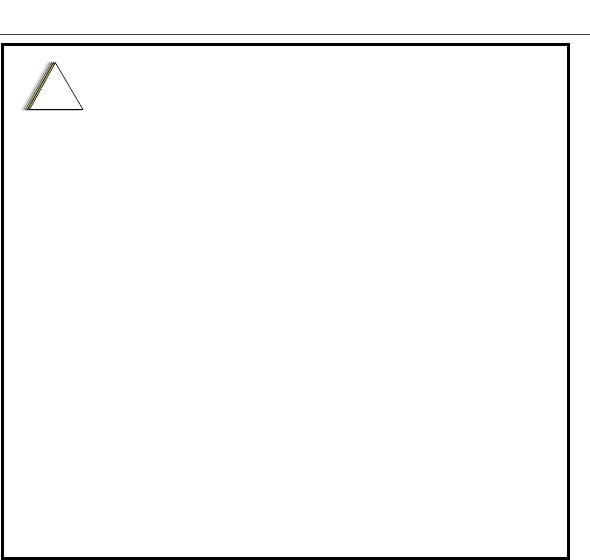
30
LOGO HERE
www.motorola.com/iden
Cleaning and Drying Considerations
This product is not water proof, and exposing the unit to liquids may result in
permanent damage to the unit.
If your radio product interior gets wet, then do not try to accelerate drying with
the use of an oven or a dryer as this will damage the radio product and void the
warranty. Instead, do the following:
1. Immediately power off the radio product.
2. Remove Battery and SIM card (if so equipped) from radio product.
3. Shake excess liquid from radio product.
4. Place the radio product and battery in an area that is at room temperature
and has good air flow.
5. Let the radio product, battery dry, and SIM card for 72 hours before
reconnecting the battery and/or powering on the radio product.
Operational Cautions
Antennas
Do not use any portable radio product that has a damaged antenna. If
a damaged antenna comes into contact with your skin, a minor burn can
result.
Batteries
All batteries can cause property damage and/or bodily injury, such as burns
if a conductive material such as jewelry, keys, or beaded chains touches
exposed terminals. The conductive material may complete an electrical
circuit (short circuit) and become quite hot. Exercise care in handling any
charged battery, particularly when placing it inside a pocket, purse, or other
container with metal objects.
!
C a u t i o n

31
Operational Cautions
If the radio product does not work after following the steps listed above, contact
your dealer for servicing information.
Clean the external surfaces of the radio product with a damp cloth, using a mild
solution of dishwashing detergent and water. Some household cleaners may
contain chemicals that could seriously damage the radio product. Avoid the use
of any petroleum-based solvent cleaners. Also, avoid applying liquids directly
on the radio product.
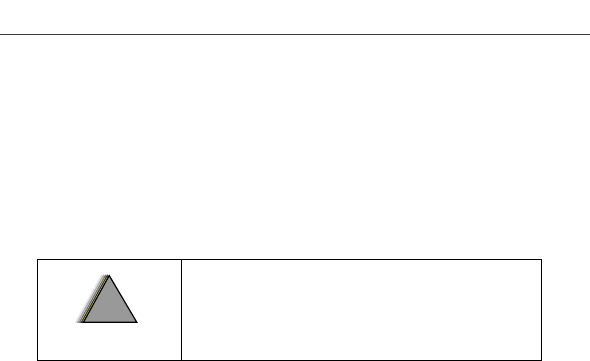
32
LOGO HERE
www.motorola.com/iden
Accessory Safety Information
IMPORTANT:
SAVE THESE ACCESSORY SAFETY INSTRUCTIONS
• Before using any battery or battery charger, read all the instructions for and
cautionary markings on (1) the battery, (2) the battery charger, which may
include a separate wall-mounted power supply or transformer, and (3) the
radio product using the battery.
• Do not expose any battery charger to water, rain, or snow as they are
designed for indoor or in-vehicle use only.
• To reduce the risk of damage to the cord or plug, pull by the plug rather
than the cord when you disconnect the battery charger from the power
source outlet.
• Do not operate any battery charger with a damaged cord or plug — replace
them immediately.
• Battery chargers may become warm during operation, but not hot. If it
becomes hot to the touch, unplug it from the power outlet immediately and
discontinue its use.
• Use of a non-recommended attachment to a battery charger may result in a
risk of fire, electric shock, or injury to persons.
• Make sure the battery charger power cord is located so that it will not be
stepped on, tripped over, or subjected to damage or stress.
• An extension cord should not be used with any battery charger unless
absolutely necessary. Use of an improper extension cord could result in a
risk of fire and electric shock. If an extension cord must be used, make sure
that:
• The pins on the plug of the extension cord are the same number, size,
and shape as those on the plug of the charger.
• The extension cord is properly wired and in good electrical condition.
• The cord size is 18AWG for lengths up to 100 feet and 16AWG for
lengths up to 150 feet.
To reduce the risk of injury, charge only the
rechargeable batteries listed in the Accessories
section of this manual. Other types of batteries
may burst, causing personal injury and damage.
!
W A R N I N G
!

33
Accessory Safety Information
• Do not operate any battery charger if it has received a sharp blow, has been
dropped, or has been damaged in any way; take it to a qualified service
technician.
• Do not disassemble a battery charger; take it to a qualified service
technician when service or repair is required. Incorrect reassembly may
result in a risk of electric shock or fire.
• Maximum ambient temperature around the power supply or transformer of
any battery charger should not exceed 40°C (104°F).
• The output power from the power supply or transformer must not exceed
the rating given on the Desktop Dual-Pocket Charger.
• The disconnection from the line voltage is made by unplugging the power
supply from the AC receptacle.
• To reduce risk of electric shock, unplug any battery charger from the outlet
before attempting any maintenance or cleaning.
For optimum charging performance, turn off the radio product while charging it
in any battery charger.

34
LOGO HERE
www.motorola.com/iden
GLOSSARY
asynchronous Data without an accompanying time signal.
Timing is built into data characters as start
and stop bits.
AT command An order entered into the computer to request
your modem to perform certain actions, such
as dial a telemodem number. AT commands
are Hayes-compatible modem commands.
baud rate Signaling speed of the modem. Common
baud rates are 2400, 4800, 9600, 19200, and
56k.
bps Bits per second. The rate at which data passes
over the telemodem line or through the air.
The basic unit of measure for serial data
transmission capacity.
burst A unit of information consisting of a sequence
of signals.
circuit-switched data Continuous data communication, such as a
modem call.
CTS The Clear to Send signal passed from the
local modem to the local terminal when the
data port is ready to transmit data. Occurs in
response to the Request To Send (RTS)
signal.

35
Glossary
command mode The mode that accepts AT commands. Also
known as Terminal Mode. When your modem
is in this mode, it is waiting to receive AT
commands that you type from your
communication software.
communication
software A computer program designed to connect
your computer to an external source, such as
another computer or a fax machine.
data services One of the functions of your iM1100 modem.
Wireless data services uses both circuit-
switched and packet data transmissions.
DCD Data Carrier Detect. An acceptable carrier
signal received by the modem over the
modem line. Also known as Received Line
Signal Indicator (RLSI).
DCE Data Communications Equipment. The
equipment that establishes, maintains and
terminates a connection. It converts data into
units of sound and vice versa for
communication over telemodem or cellular
networks.
default A factory preset choice that, under normal
circumstances, works best for your system.
You can either accept the default or change it.
dialing directory A modem book of frequently called modem
numbers that you can set up and maintain in
your communication software.

36
LOGO HERE
www.motorola.com/iden
DTE Data Terminal Equipment. A computer or
hand-held device that generates and receives
data, and provides functions that control data
communications through a device like the
modem.
hand-held devices Small computing appliances, such as palm
tops, personal digital assistants, and pen-
based computers.
home agent The server that is responsible for routing data
from your home network to your computer.
iDEN service provider Provider of circuit data services and packet
data services.
Internet Inter-connected networks that all use the
TCP/IP protocols.
Intranet A private network inside a company or
organization.
laptops Portable computers, such as notebooks and
subnotebooks.
mobile IP Mobile Internet Protocol—a locating device.
Provides the capability to locate you on the
network at all times.
modem MOdulator/DEModulator. An electronic
device enabling digital data to be sent over
analog transmission facilities. Converts a
digital signal to analog and back to digital
again.

37
Glossary
non-volatile memory Permanently stored information. It is not lost
when the power is turned off.
packet data A block of data for transmission.
parity bit An error-checking method in asynchronous
transmission. An additional non-data bit
added to a group of bits to indicate whether
the number of bits in the group is odd or even.
PIN Personal Identification Number. A security
number that allows you to access a system.
PPP Point-to-point protocol.
protocol A set of conventions regulating the format
and relative timing of message transfer
between two communication terminals.
RAM Random Access Memory. The working
memory of the computer where you can enter
information and call up data.
RTS Request to Send. Signal sent from the local
terminal to the local modem to prepare the
modem for data transmission.
serial port An input/output (I/O) port that transmits data
one bit at a time; as opposed to a parallel port
which transmits multiple (usually eight) bits
simultaneously. RS232C is a common serial
interface standard.

38
LOGO HERE
www.motorola.com/iden
service provider Provides your computer with Internet access.
Also known as an ISP (Internet Service
Provider).
service-specific
software A program that is designed for a designated
online service.
stop bit A data bit used in asynchronous transmission
to signal the end of a character.
system administrator The person responsible for monitoring
computer activity in a specified area, such as
a department or a company.
terminal mode The mode that accepts AT commands. Also
known as Command Mode. When your
modem is in this mode, it is waiting to receive
AT commands that you type from your
communication software.
transmission rate The rate at which data is transferred, in bits
per second.
wireless data services See data services.